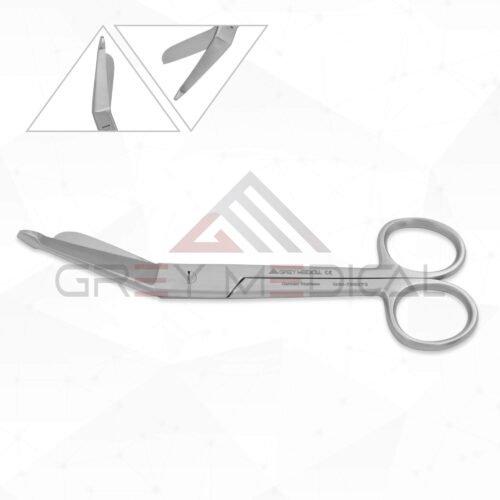Lister vs. Bandage Scissors: What's the Difference?

In the world of medical instruments, precision and design are paramount. Seemingly small variations in a tool can have a significant impact on its function and safety. This is certainly true when comparing Lister bandage scissors vs. general bandage scissors. While they may look similar to the untrained eye, each is designed for specific tasks. Understanding their distinct features is crucial for healthcare professionals to ensure they are using the right tool for the job, promoting both efficiency and patient safety.

The Foundation: Understanding Standard Bandage Scissors
Before exploring the specifics of the Lister design, it is important to understand the fundamental characteristics of a standard pair of medical scissors. These instruments are a staple in first aid kits, clinics, and hospitals. Their primary purpose is to cut through materials like gauze, medical tape, and dressings without harming the patient's skin.
The defining feature of this tool is its unique blade design. The lower blade has a blunted, flattened tip, often referred to as a "duckbill" or safety tip. This smooth, wide surface is designed to slide between a patient's skin and the dressing. This allows the user to lift the material away from the body, creating a safe cutting plane and preventing accidental punctures or lacerations. The upper blade is sharp, enabling it to slice cleanly through various medical materials.
The Lister Innovation: A Refined Design for Safety
So, where do Lister bandage scissors fit into this picture? A Lister scissor is a specific and highly recognized type of bandage scissors. Named after the pioneering British surgeon Sir Joseph Lister, who championed sterile surgery, this design incorporates a key refinement for enhanced safety and performance.
The most notable feature of Lister bandage scissors is the prominent, flattened probe on the tip of the lower blade. This guide tip is more pronounced than on many standard models. Its purpose is to effectively lift and separate the bandage from the skin, guiding the blades smoothly as they cut. This design significantly minimizes the risk of injuring the patient, which was a core principle of Sir Lister's medical philosophy. The upper blade remains sharp for efficient cutting, while the entire instrument is often angled, allowing the user's hand to remain clear of the cutting area for better visibility.
Key Differences at a Glance
While a Lister scissor is a type of bandage scissor, not all bandage scissors are Listers. The primary distinction lies in the specific design and prominence of the safety tip on the lower blade. Lister models have a very distinct and effective guide probe that makes them exceptionally safe for cutting dressings close to the skin.
Another difference can be the angle of the blades relative to the handles. Lister scissors are almost always designed with an offset angle. This ergonomic feature keeps the user's knuckles from obstructing their view of the cutting site, which is especially helpful during delicate procedures. While some standard models might be angled, it is a hallmark feature of the Lister design. Companies like GreyMedical®, a privately owned medical technology company dedicated to innovation, craft these instruments with precision, ensuring every angle and surface meets the highest standards of surgical excellence.
When to Use Each Type
Choosing between a Lister and a standard model often comes down to the specific application and user preference. For general first aid or less critical dressing changes, a standard pair of bandage scissors is often sufficient. They are versatile, reliable, and provide a basic level of safety for common tasks.
However, in professional medical settings such as hospitals, emergency rooms, or surgical environments, the Lister design is frequently preferred. Its superior safety features make it the ideal choice for cutting away thick dressings, casts, or clothing from an injured patient. The angled design and robust guide tip provide the control and visibility needed for high-stakes situations, upholding the legacy of safety that Sir Joseph Lister himself established.
Conclusion
In summary, the comparison of Lister bandage scissors vs. general bandage scissors reveals a story of refinement and purpose-driven design. All bandage scissors share the fundamental goal of safely cutting materials without harming skin, achieved through a blunted lower blade. The Lister model, however, elevates this concept with a more pronounced guide tip and an ergonomic offset angle, offering an enhanced level of safety and control favored in professional healthcare. Understanding this distinction allows clinicians and first responders to select the most appropriate instrument, ensuring patient care is always delivered with precision and safety.
- Art
- Causes
- Crafts
- Dance
- Drinks
- Film
- Fitness
- Food
- Games
- Gardening
- Health
- Home
- Literature
- Music
- Networking
- Other
- Party
- Religion
- Shopping
- Sports
- Theater
- Wellness


